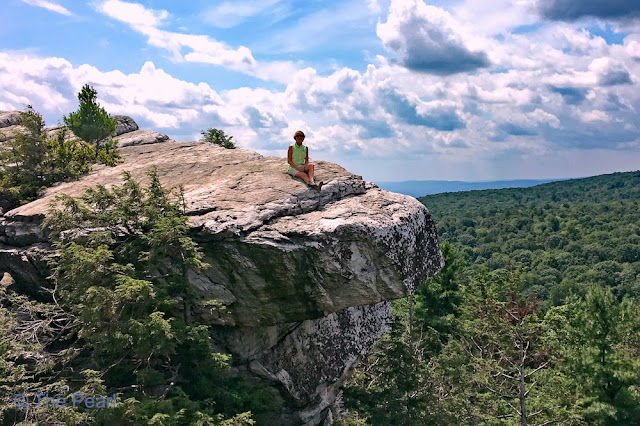“The most rewarding things you do in life are often the ones that look like they cannot be done." —Arnold Palmer
We had planned to spend a few weeks doing a road trip to Nova Scotia starting last week, but we have a grand-baby due soon, so we decided we better stay closer to Pennsylvania until the baby arrives. We'd hate to have to do a 15 hour run from Halifax to Bloomsburg when Bryt goes into labor. So we're filling our days with things around here. We spent two days with friends in Connecticut at the beginning of the week, we ate a lot, talked a lot and had a wonderful time catching up with Ted and Sally.
On our way home we did a little hiking in the Catskills Mountains. There are A LOT of places to hike and beautiful places to visit in the Catskills, but we decided on Minnewaska State Park Preserve. It's situated on the dramatic Shawangunk Mountain ridge, which rises more than 2,000 feet above sea level and is surrounded by rugged, rocky terrain. The park features numerous waterfalls, three crystalline sky lakes, dense hardwood forests, incising sheer cliffs and ledges opening to beautiful views, 35 miles of carriage roads and 50 miles of footpaths.
It would be impossible to see all of Minnewaska’s beautiful spots in one day, so we decided to take in some of the best views from the Gertrude's Nose Tail. It's a round trip hike that includes four different trails and is approximately 7.5 miles long. The loop hike started on a nice, smooth, fairly level carriage-road that took us around part of Lake Minnewaska. The next section was also on a carriage-road with a slight increase in elevation, but still a walk in the park compared to what was to come.
Millbrook Mountain Carriage Road gave us some wonderful views of the Palmaghatt Ravine. One of the interesting geologic features along this section was a large glacial erratic called Patterson's Pellet. A glacial erratic is simply rocks that were picked up by the glaciers and dropped out as they melted.
Shortly after that we left the carriage-road and began the Gertrude's Nose Footpath (2.7 miles). It was challenging, but spectacular, it meandered along quartz conglomerate escarpment, laced with deep cravats and offered spectacular views of the Palmaghatt Ravine and Hudson Valley. The trail included short, but steep, inclines and declines, as well as two moderate rock scrambles. I thought the hardest part of our hike would be over when we reached the Millbrook Mountain Footpath, but we still had another 1.2 miles of steep inclines and declines before we would be back to the lake. At the highest point along this trail we were rewarded with a peak with a 360º view.
A few photos of the Gertrude's Nose Footpath.
At some points the trail was hard to find...this small peak was the only way to continue on to Gertrude's Nose.A few photos of the Gertrude's Nose Footpath.
Photos from the Millbrook Mountain Footpath. It was definitely a workout.
Sights along the trail
There were blueberry bushes...everywhere. We enjoyed some as a snack along the way.
Some of the beautiful vistas we enjoyed along the hike.
A few rain showers in the distance. The showers caught up with us for awhile, but the trees kept us pretty dry.
At one of the higher peaks we found these rock markers and lots of shrubby Pitch Pines.
Once we reached the lake both Stan and I waded into the water to cool off. We were now back on the Lake Minnewaska Carriage Road...only one more mile back to the car. Of course this road started at lake level and we had to get back to the top of the cliff, so we were still climbing. We took our time and enjoyed the views of the lake, stopping at several places to relax. We definitely got a good workout on this hike.Minnewaska is a name derived from Native American languages meaning "good water". One of the most enjoyable parts of this hike, besides the amazing views, was the smell of the fresh air. A combination of pine, juniper, wildflowers and blueberries...it was absolutely incredible. I can share pictures of what we saw, but unfortunately I can't share the amazing smell.
Views of the lake on our last mile of the hike.
Stan relaxing and taking in the view.
Almost back to our car...by this time we (I) was pretty tired.
This is the loop we made at Minnewaska State Park. The orange lines represent carriage-roads and the blue were the footpaths.
The statics on our hike today





















































